I
Ilya Ryvin
Guest
Feed from Wornandwound.com .Borealis Watch Forum takes no responsibility for any of the content posted.
In the summer of 2016, we wrote about Sinn’s development of a new pilot’s watch standard through DIN, the German Institute for Standardization. To summarize, the resulting DIN 8330 standard codifies what it means to be a pilot watch, building on the TESTAF standard first introduced in 2012. To be DIN-certified, a watch has to meet certain criteria with regard to general functionality, legibility, and performance under extreme conditions—standards that are even more explicit than those first outlined by TESTAF. For example, pilot’s watches tested under these guidelines must be water-resistant to 200 meters, must remain functional within a temperature range of –45°C up to 80°C, and must be able to handle repeated changes in air pressure, among a handful of other requirements. To read more about about the DIN 8330 standard, click here.
Sinn’s announcement of these guidelines came with the release of three new watches designed around the new standard and today we’re taking a look at one of them—the 103 Ti UTC IFR.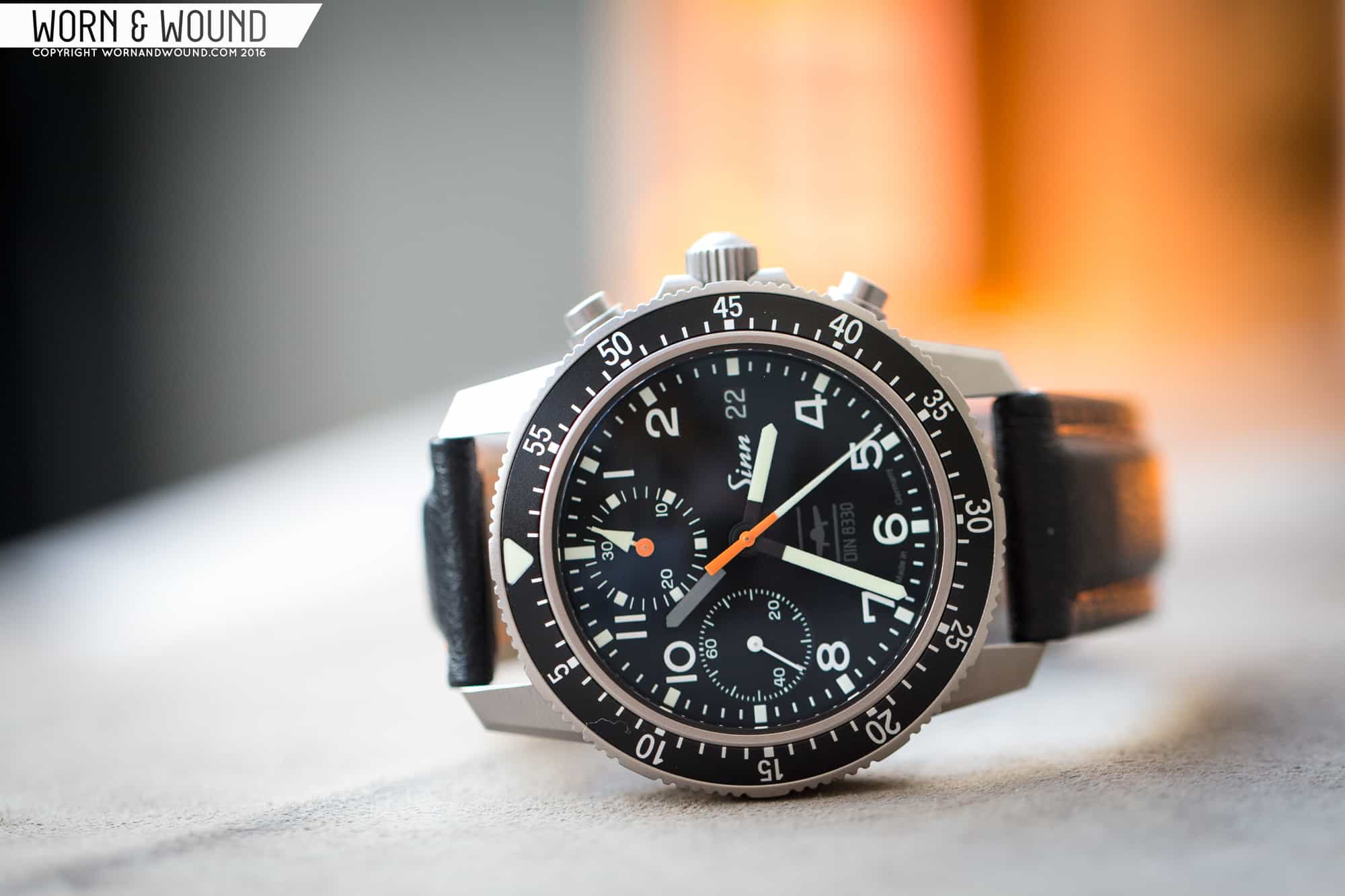 The 103 has also long been a Sinn staple, and over the years the brand has released numerous variations on the core design, among them the 103 St Sa, the Titanium DIAPAL, and the Ti UTC IFR’s direct predecessor—the 103 Titanium UTC TESTAF.
The 103 has also long been a Sinn staple, and over the years the brand has released numerous variations on the core design, among them the 103 St Sa, the Titanium DIAPAL, and the Ti UTC IFR’s direct predecessor—the 103 Titanium UTC TESTAF.
This latest iteration is Sinn’s ultimate expression of a tool watch—it’s over-engineered and packed with tons of Sinn’s proprietary tech that allow the watch to meet the DIN 8330 standard. Aesthetically, it falls in line with many of the design cues we first saw with Sinn’s batch of TESTAF-certified watches, though the design here is further emphasized for clarity (read our review of Sinn’s flagship EZM 10).
At $3,470 on strap and $3,780 on bracelet, it’s not an inexpensive package, but it’s one that comes with a lot packed into it. Let’s take a closer look.
$3470
Sinn 103 Ti UTC IFR Review
Case
Bead-blasted titanium
Movement
Valjoux 7750 + GMT
Dial
Black
Lume
Super-LumiNova
Lens
Double-domed sapphire with AR (both sides)
Strap
Black leather w/ orange contrast stitch
Water Resistance
20 bar/200 meters
Dimensions
41mm x 48.1mm
Thickness
17.6mm
Lug Width
20mm
Crown
5mm x 3mm; screw down
Warranty
3 years
Price
$3470
Case
The case of the 103 Ti UTC IFR measures 41mm wide, 48.1mm lug-to-lug, and 17.6mm thick. Some thoughts on the dimensions. The overall size is very comfortable when worn, with the tempered length making it wearable on a wide range of wrist sizes. The thickness on paper, however, might give one pause. To compare, the standard 103 St is about 16mm, so the 103 Ti UTC IFR definitely has some extra girth. But it’s the way that girth is distributed that really makes a difference.

The Sinn 103 Ti UTC IFR is a thick watch, with a lot of the thickness coming through the case back.
Unlike the 103 St, which gets a good chunk of its height from the highly domed acrylic lens, the 103 Ti UTC IFR gets its height from its bulging case back, which is topped off with a domed sapphire crystal. Though it’s cool in appearance, in a practical sense it forces the watch to sit a bit higher off the wrist rather than sink into it. It’s by no means uncomfortable—in fact, I really like the way the 103 wears—but it is worth noting for those who consider the height of a watch a sink or swim issue.
In terms of the overall aesthetic and design, the case of the 103 is an attractive mix of hard lines and angles that recall numerous vintage references, particularly the Breguet Type XX watches from the ‘60s and ‘70s and the second-generation Heuer Autavia. The case is matte, bead-blasted titanium, which has a grey, slightly warm tone. The thing about Sinn cases is that while they tend to be relatively straightforward in design, the finishing is well executed.
And of course, there’s the tech. To prevent the watch from filling with water, or any moisture for that matter, Sinn applies their proprietary, three-pronged Ar-Dehumidifying technology. First, a drying capsule placed in the case right off seven is filled with copper sulfate, which absorbs and binds any moisture that enters the watch.
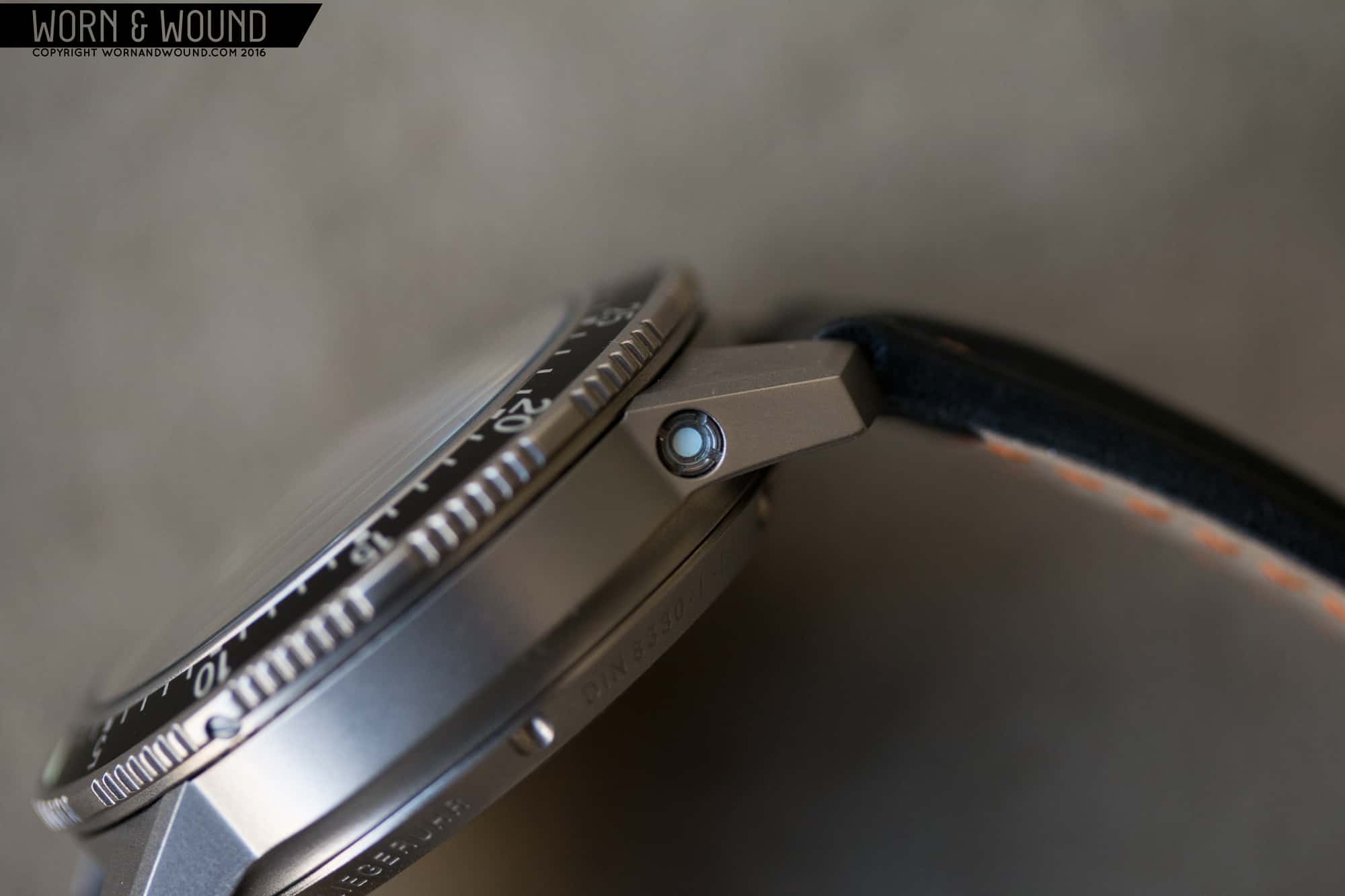
It starts off a light shade of blue, and it darkens as it absorbs moisture over time.
If it were to darken suddenly, then that would likely indicate a failed seal, thereby prompting service. Second, Sinn fills their cases with an inert gas, which creates a zero-to-low humidity atmosphere inside the watch by pushing out any moisture that may have gotten in there during assembly. This keeps the oil from aging prematurely, and will prevent the crystal from fogging if there is a sudden drop in temperature. Finally, Sinn uses special EDR (Extreme Diffusion-Reducing) seals rather than those made of nitrile rubber to ensure less moisture enters the case (about 25% of what standard seals permit). To read more about Sinn’s Ar-Dehumidifying technology, click here.


The bezel features a 60-click, bi-directional ratcheting mechanism with a metal countdown insert. Unlike most bezels which are snapped onto a case, Sinn’s captive bezel is, as the company describes it, “a safety system” that ensures the bezel cannot be knocked off accidentally. It’s unclear exactly how this works, but as you can see from the side, the bezel has a series of small screws which likely assist in keeping it attached to the ratcheting system. Regardless, the bezel boasts a really satisfying, tactile action with springy clicks in both directions.
Dial
The dial tackles the 7750 Valjoux-based template of the standard 103, but implements a few dramatic changes. First, you’ll notice that the 12-hour totalizer at six is no longer there, replaced by a graphic DIN 8330 stamp. As a result, what you have here is essentially a 30-minute chronograph, which I find a bit odd. The Sinn EZM 13 features a modified 60-minute totalizer, which definitely would have been cool here, but I digress.
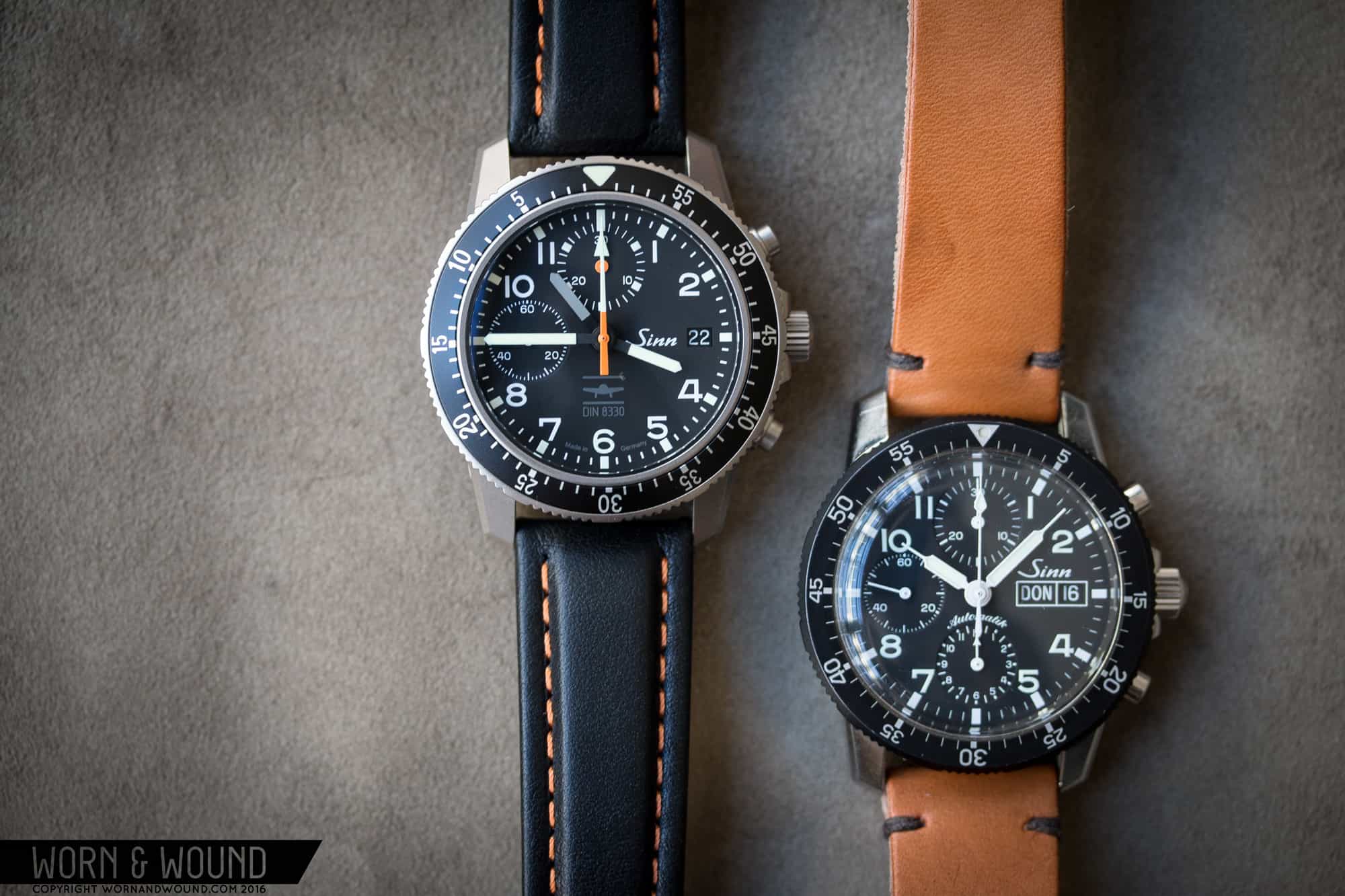
The Sinn 103 Ti UTC IFR next to the 103 St.
Aesthetically, I like the facelift the Ti UTC IFR gives the 103 line. It’s a more contemporary approach to a relatively vintage design. The goal here is to maximize legibility, which is something Sinn does very well. The primary index features large Arabic numerals, omitting the three (for the date), and nine and 12 (for the two totalizers). Lumed rectangles below this index are positioned at five-minute intervals, with simple lines in place for the remaining minutes. The sub-dial at nine is the active seconds, and the one at 12 is, as mentioned, a 30-minute totalizer. Within this sub-dial you have large, lumed rectangles positioned at every five-minutes, a detail that really makes the register easy to read, even at a glance. Furthermore, the “6” on the primary index is lumed.

The handset also gets an upgrade. Gone are the syringe hands, replaced with bold, lumed swords. Orange accents color code and emphasize the chronograph function. The central chronograph hand—a long tapering needle—features an orange base, a detail that is then carried over to the lumed arrowhead at the 30-minute totalizer, which too has an orange base. You may be wondering, why orange? Because orange is a highly legible color not represented by any other function in a cockpit, the way green and yellow are, for example. Its limited application here is effective and not overly loud, and it gives the watches some personality without drawing too much attention to it.
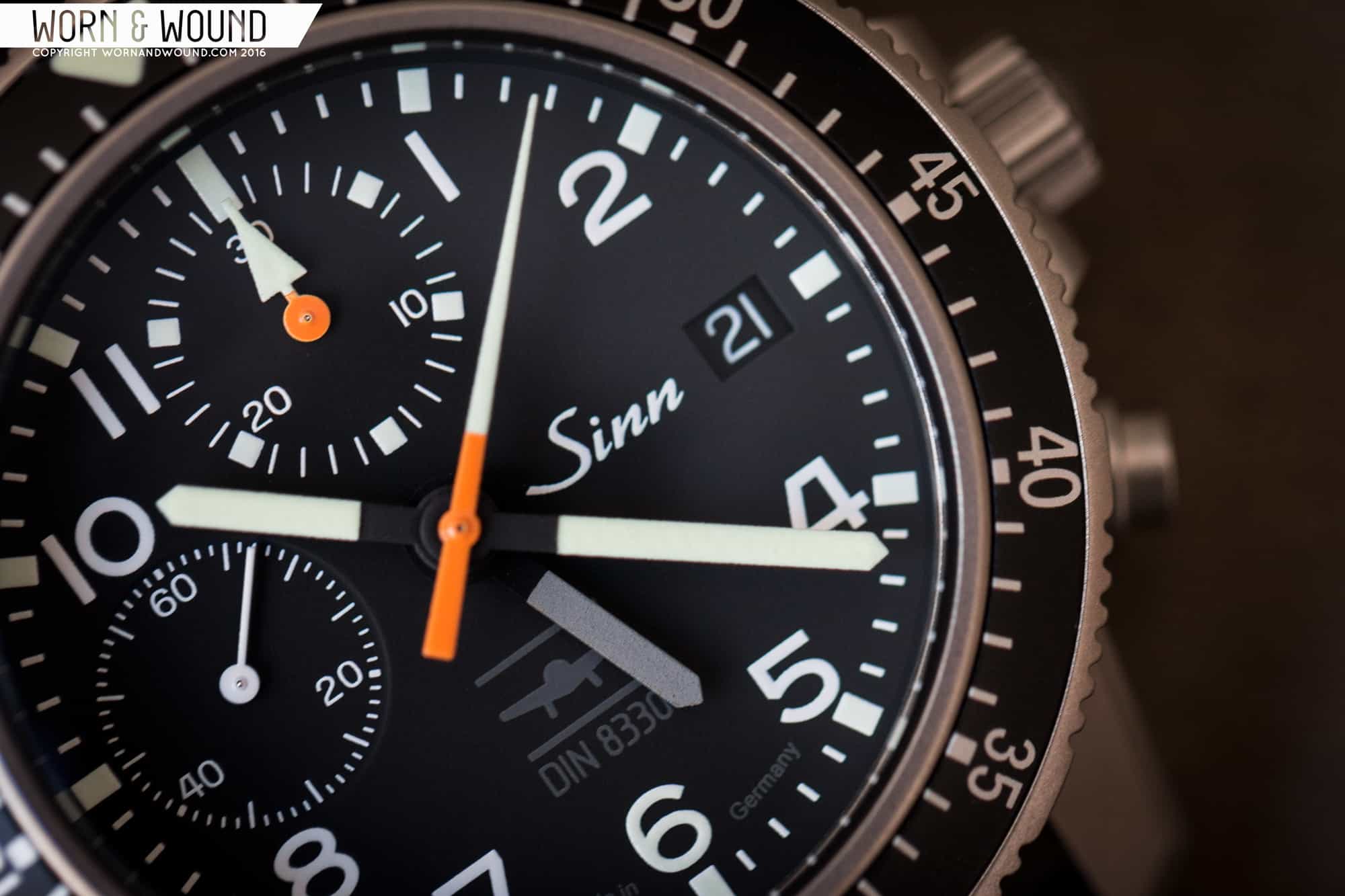
With the crown pulled out to the second position, turning it counter-clockwise will adjust the UTC hand. Turning it clockwise will manipulate the date.
Finally, there is a dark grey UTC hand. What’s interesting about its implementation here is that unlike other brands, Sinn chose to downplay the hand by making it tonally similar to the dial. It’s still visible and it’s there if you need it, but it’s largely unobtrusive if you don’t. Plus, you can always tuck it under the hour hand if you don’t want it there at all.
Straps and Wearability
The 103 Ti UTC IFR is available right now on a black leather strap or a matching titanium bracelet. The sample we have in for review is on the leather strap. It’s a high-quality band, padded at the center and adorned with contrast orange stitching. It’s not exactly to my taste, especially the contest stitching, but I rarely love OEM straps and swapping this one out is not an issue. The bracelet, though I haven’t handled it, appears to be in line with most other H-link bracelets from Sinn, which I quite like. They don’t pull on the hair on my wrist and they’re just very comfortable to wear.

The Sinn 103 Ti UTC IFR looks perfect on a 7-inch wrist.
As I wrote above, the 103 Ti UTC IFR is a thick watch, but it’s not uncomfortable. Being that it is titanium, it is also incredibly light on the wrist, with the head weighing only 69 grams. I found the watch very pleasant during the time I wore it.
I’d like to take a moment to once again emphasize just how legible this watch is. Despite all the information on it, the dial is high-contrast and very easy to read. At a glance, the primary index and handset immediately pop. Furthermore, that clarity is further aided by the doubled domed, distortion-free sapphire crystal with AR on both sides.
Movement
As I wrote above, the engine powering the 103 Ti UTC IFR is a Valjoux 7750 with an added GMT complication. It’s an automatic workhorse, time-tested over the years and beloved for its reliability and hard-wearing nature. Sinn generally does a good job at decorating their movements, and that’s no exception here.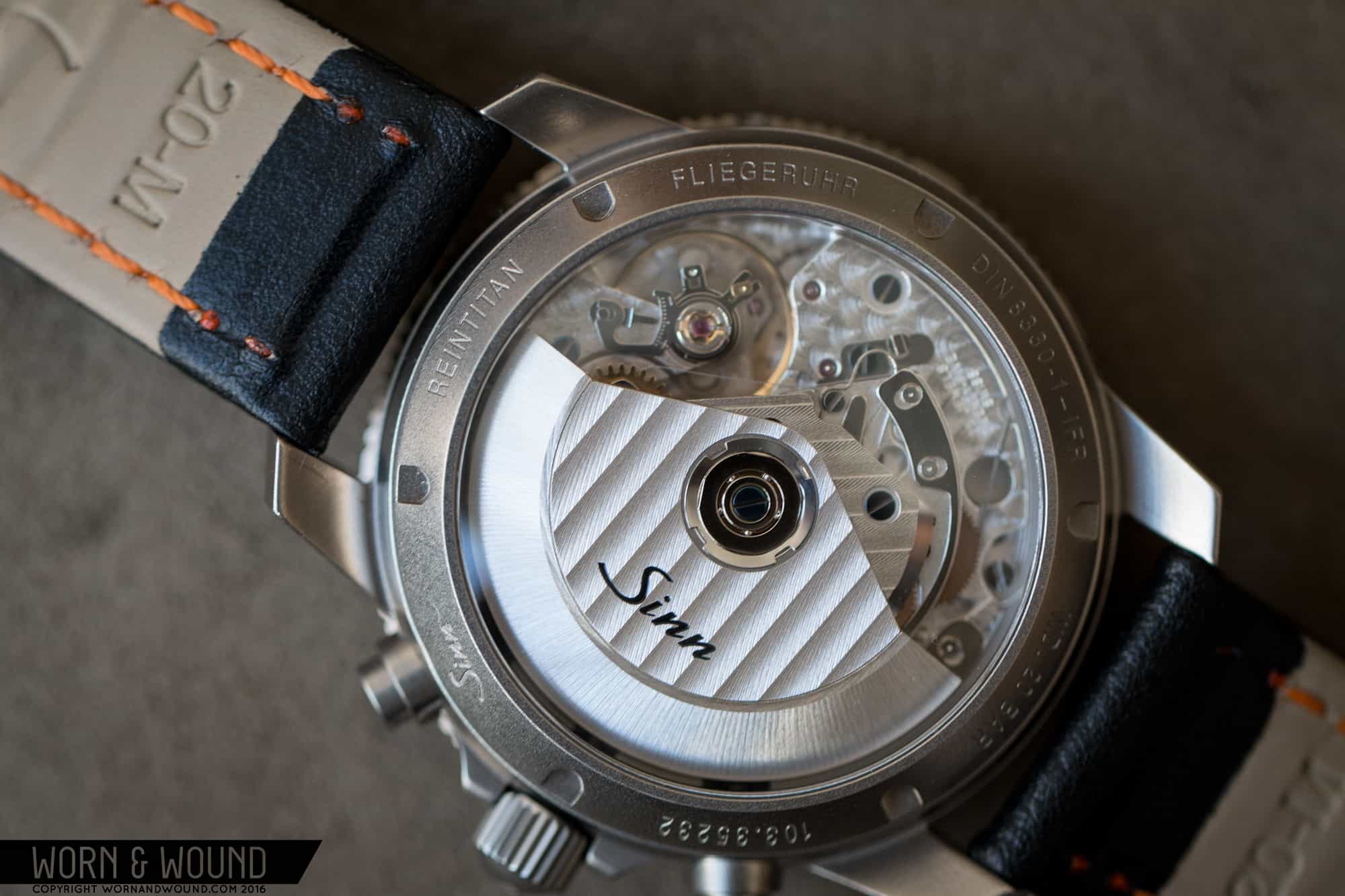
Conclusion
All in all, I really like what Sinn is offering with 103 Ti UTC IFR. It’s a tough-as-nails addition to the 103 lineup, with a styling that allows for easy daily wear. Plus, it’s a great choice for frequent flyers. If I had to really find one thing to pick on, it would be the lack of a 12-hour totalizer at six, but it’s not a detail that would stop me from enjoying the watch or the complication.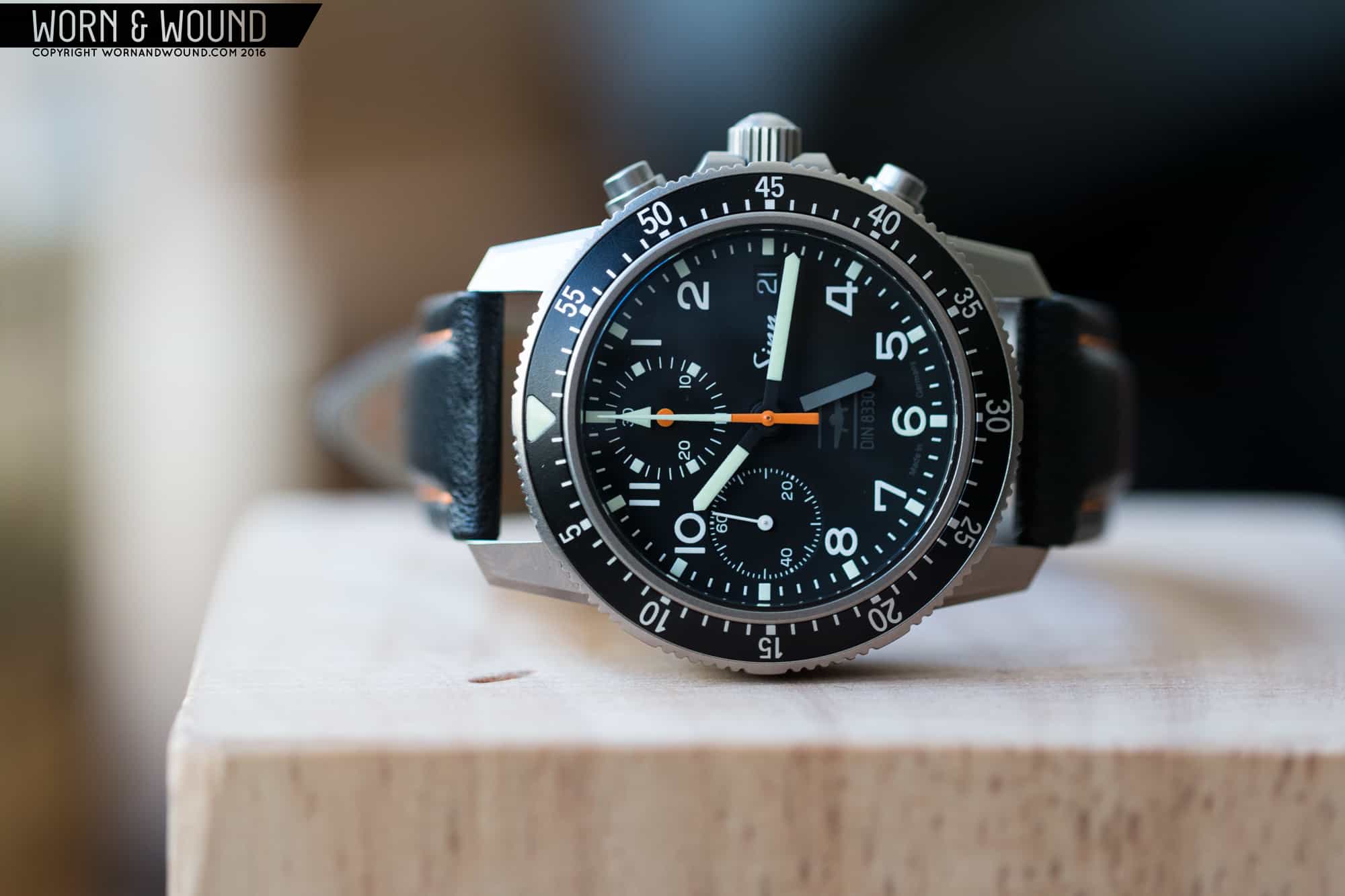 As far as pricing goes, at $3,470 on strap and $3,780 on bracelet, I think Sinn placed it accordingly when one considers the other watches in the range and the level of tech being offered here. Should you love the styling of this watch, but would prefer to pay less, the non-UTC variant comes with a significant discount.
As far as pricing goes, at $3,470 on strap and $3,780 on bracelet, I think Sinn placed it accordingly when one considers the other watches in the range and the level of tech being offered here. Should you love the styling of this watch, but would prefer to pay less, the non-UTC variant comes with a significant discount.
For more information, visit Sinn. To purchase, visit WatchBuys.
Images from this post:
The post Sinn 103 Ti UTC IFR Review appeared first on worn&wound.
Continue reading...
Let us know your thoughts and impressions.
In the summer of 2016, we wrote about Sinn’s development of a new pilot’s watch standard through DIN, the German Institute for Standardization. To summarize, the resulting DIN 8330 standard codifies what it means to be a pilot watch, building on the TESTAF standard first introduced in 2012. To be DIN-certified, a watch has to meet certain criteria with regard to general functionality, legibility, and performance under extreme conditions—standards that are even more explicit than those first outlined by TESTAF. For example, pilot’s watches tested under these guidelines must be water-resistant to 200 meters, must remain functional within a temperature range of –45°C up to 80°C, and must be able to handle repeated changes in air pressure, among a handful of other requirements. To read more about about the DIN 8330 standard, click here.
Sinn’s announcement of these guidelines came with the release of three new watches designed around the new standard and today we’re taking a look at one of them—the 103 Ti UTC IFR.
 The 103 has also long been a Sinn staple, and over the years the brand has released numerous variations on the core design, among them the 103 St Sa, the Titanium DIAPAL, and the Ti UTC IFR’s direct predecessor—the 103 Titanium UTC TESTAF.
The 103 has also long been a Sinn staple, and over the years the brand has released numerous variations on the core design, among them the 103 St Sa, the Titanium DIAPAL, and the Ti UTC IFR’s direct predecessor—the 103 Titanium UTC TESTAF.This latest iteration is Sinn’s ultimate expression of a tool watch—it’s over-engineered and packed with tons of Sinn’s proprietary tech that allow the watch to meet the DIN 8330 standard. Aesthetically, it falls in line with many of the design cues we first saw with Sinn’s batch of TESTAF-certified watches, though the design here is further emphasized for clarity (read our review of Sinn’s flagship EZM 10).
At $3,470 on strap and $3,780 on bracelet, it’s not an inexpensive package, but it’s one that comes with a lot packed into it. Let’s take a closer look.
$3470
Sinn 103 Ti UTC IFR Review
Case
Bead-blasted titanium
Movement
Valjoux 7750 + GMT
Dial
Black
Lume
Super-LumiNova
Lens
Double-domed sapphire with AR (both sides)
Strap
Black leather w/ orange contrast stitch
Water Resistance
20 bar/200 meters
Dimensions
41mm x 48.1mm
Thickness
17.6mm
Lug Width
20mm
Crown
5mm x 3mm; screw down
Warranty
3 years
Price
$3470
Case
The case of the 103 Ti UTC IFR measures 41mm wide, 48.1mm lug-to-lug, and 17.6mm thick. Some thoughts on the dimensions. The overall size is very comfortable when worn, with the tempered length making it wearable on a wide range of wrist sizes. The thickness on paper, however, might give one pause. To compare, the standard 103 St is about 16mm, so the 103 Ti UTC IFR definitely has some extra girth. But it’s the way that girth is distributed that really makes a difference.

The Sinn 103 Ti UTC IFR is a thick watch, with a lot of the thickness coming through the case back.
Unlike the 103 St, which gets a good chunk of its height from the highly domed acrylic lens, the 103 Ti UTC IFR gets its height from its bulging case back, which is topped off with a domed sapphire crystal. Though it’s cool in appearance, in a practical sense it forces the watch to sit a bit higher off the wrist rather than sink into it. It’s by no means uncomfortable—in fact, I really like the way the 103 wears—but it is worth noting for those who consider the height of a watch a sink or swim issue.
In terms of the overall aesthetic and design, the case of the 103 is an attractive mix of hard lines and angles that recall numerous vintage references, particularly the Breguet Type XX watches from the ‘60s and ‘70s and the second-generation Heuer Autavia. The case is matte, bead-blasted titanium, which has a grey, slightly warm tone. The thing about Sinn cases is that while they tend to be relatively straightforward in design, the finishing is well executed.
And of course, there’s the tech. To prevent the watch from filling with water, or any moisture for that matter, Sinn applies their proprietary, three-pronged Ar-Dehumidifying technology. First, a drying capsule placed in the case right off seven is filled with copper sulfate, which absorbs and binds any moisture that enters the watch.

It starts off a light shade of blue, and it darkens as it absorbs moisture over time.
If it were to darken suddenly, then that would likely indicate a failed seal, thereby prompting service. Second, Sinn fills their cases with an inert gas, which creates a zero-to-low humidity atmosphere inside the watch by pushing out any moisture that may have gotten in there during assembly. This keeps the oil from aging prematurely, and will prevent the crystal from fogging if there is a sudden drop in temperature. Finally, Sinn uses special EDR (Extreme Diffusion-Reducing) seals rather than those made of nitrile rubber to ensure less moisture enters the case (about 25% of what standard seals permit). To read more about Sinn’s Ar-Dehumidifying technology, click here.


The bezel features a 60-click, bi-directional ratcheting mechanism with a metal countdown insert. Unlike most bezels which are snapped onto a case, Sinn’s captive bezel is, as the company describes it, “a safety system” that ensures the bezel cannot be knocked off accidentally. It’s unclear exactly how this works, but as you can see from the side, the bezel has a series of small screws which likely assist in keeping it attached to the ratcheting system. Regardless, the bezel boasts a really satisfying, tactile action with springy clicks in both directions.
Dial
The dial tackles the 7750 Valjoux-based template of the standard 103, but implements a few dramatic changes. First, you’ll notice that the 12-hour totalizer at six is no longer there, replaced by a graphic DIN 8330 stamp. As a result, what you have here is essentially a 30-minute chronograph, which I find a bit odd. The Sinn EZM 13 features a modified 60-minute totalizer, which definitely would have been cool here, but I digress.

The Sinn 103 Ti UTC IFR next to the 103 St.
Aesthetically, I like the facelift the Ti UTC IFR gives the 103 line. It’s a more contemporary approach to a relatively vintage design. The goal here is to maximize legibility, which is something Sinn does very well. The primary index features large Arabic numerals, omitting the three (for the date), and nine and 12 (for the two totalizers). Lumed rectangles below this index are positioned at five-minute intervals, with simple lines in place for the remaining minutes. The sub-dial at nine is the active seconds, and the one at 12 is, as mentioned, a 30-minute totalizer. Within this sub-dial you have large, lumed rectangles positioned at every five-minutes, a detail that really makes the register easy to read, even at a glance. Furthermore, the “6” on the primary index is lumed.

The handset also gets an upgrade. Gone are the syringe hands, replaced with bold, lumed swords. Orange accents color code and emphasize the chronograph function. The central chronograph hand—a long tapering needle—features an orange base, a detail that is then carried over to the lumed arrowhead at the 30-minute totalizer, which too has an orange base. You may be wondering, why orange? Because orange is a highly legible color not represented by any other function in a cockpit, the way green and yellow are, for example. Its limited application here is effective and not overly loud, and it gives the watches some personality without drawing too much attention to it.

With the crown pulled out to the second position, turning it counter-clockwise will adjust the UTC hand. Turning it clockwise will manipulate the date.
Finally, there is a dark grey UTC hand. What’s interesting about its implementation here is that unlike other brands, Sinn chose to downplay the hand by making it tonally similar to the dial. It’s still visible and it’s there if you need it, but it’s largely unobtrusive if you don’t. Plus, you can always tuck it under the hour hand if you don’t want it there at all.
Straps and Wearability
The 103 Ti UTC IFR is available right now on a black leather strap or a matching titanium bracelet. The sample we have in for review is on the leather strap. It’s a high-quality band, padded at the center and adorned with contrast orange stitching. It’s not exactly to my taste, especially the contest stitching, but I rarely love OEM straps and swapping this one out is not an issue. The bracelet, though I haven’t handled it, appears to be in line with most other H-link bracelets from Sinn, which I quite like. They don’t pull on the hair on my wrist and they’re just very comfortable to wear.

The Sinn 103 Ti UTC IFR looks perfect on a 7-inch wrist.
As I wrote above, the 103 Ti UTC IFR is a thick watch, but it’s not uncomfortable. Being that it is titanium, it is also incredibly light on the wrist, with the head weighing only 69 grams. I found the watch very pleasant during the time I wore it.
I’d like to take a moment to once again emphasize just how legible this watch is. Despite all the information on it, the dial is high-contrast and very easy to read. At a glance, the primary index and handset immediately pop. Furthermore, that clarity is further aided by the doubled domed, distortion-free sapphire crystal with AR on both sides.
Movement
As I wrote above, the engine powering the 103 Ti UTC IFR is a Valjoux 7750 with an added GMT complication. It’s an automatic workhorse, time-tested over the years and beloved for its reliability and hard-wearing nature. Sinn generally does a good job at decorating their movements, and that’s no exception here.

Conclusion
All in all, I really like what Sinn is offering with 103 Ti UTC IFR. It’s a tough-as-nails addition to the 103 lineup, with a styling that allows for easy daily wear. Plus, it’s a great choice for frequent flyers. If I had to really find one thing to pick on, it would be the lack of a 12-hour totalizer at six, but it’s not a detail that would stop me from enjoying the watch or the complication.
 As far as pricing goes, at $3,470 on strap and $3,780 on bracelet, I think Sinn placed it accordingly when one considers the other watches in the range and the level of tech being offered here. Should you love the styling of this watch, but would prefer to pay less, the non-UTC variant comes with a significant discount.
As far as pricing goes, at $3,470 on strap and $3,780 on bracelet, I think Sinn placed it accordingly when one considers the other watches in the range and the level of tech being offered here. Should you love the styling of this watch, but would prefer to pay less, the non-UTC variant comes with a significant discount.For more information, visit Sinn. To purchase, visit WatchBuys.
Images from this post:
The post Sinn 103 Ti UTC IFR Review appeared first on worn&wound.
Continue reading...
Let us know your thoughts and impressions.
